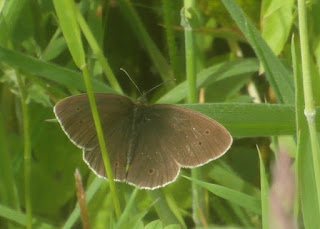This blog may help people explore some of the 'hidden' issues involved in certain media treatments of environmental and scientific issues. Using personal digital images, it's also intended to emphasise seasonal (and other) changes in natural history of the Swansea (South Wales) area. The material should help participants in field-based modules and people generally interested in the natural world. The views are wholly those of the author.
Tuesday, 30 June 2015
Sunday, 28 June 2015
Friday, 26 June 2015
Seeing the Changes 979
In Loughor, Rosebay willowherb (Epilobium angustifolium) was flowering. In Bynea, Ragwort (Senecio jacobaea); Ribbed melilot (Melilotus officinalis); Perforate St John's wort (Hypericum perforatum) and Great mullein (Verbascum thapsus) were in bloom. In that location, there were also Blue-tailed damselflies (Ischmura elegans) and a hunting digger wasp (probably Mellinus arvensis).
Thursday, 25 June 2015
Wednesday, 24 June 2015
Poking the Pig
The Roslin Institute may be creating the world's first commercially accepted GM domestic animals (http://www.theguardian.com/science/2015/jun/23/could-these-piglets-become-britains-first-commercially-viable-gm-animals). They have modified pigs, using techniques that do not involve retroviruses to transfer genes or changing antibiotic resistance, so that the pig's immune system is more like that of a warthog. African swine fever kills pigs by 'sending their immune systems into overdrive'. It also infects warthogs but they quickly recover as their immune systems respond more modestly. The hope is that the modified pigs will be healthier than their unmodified cousins and this will reduce the incidence of losses in pig colonies (which can be very high). The claim is that the only remaining obstructions to the adoption of the super pigs are legal rather than scientific
Hair Today (and Gone Tomorrow?)
There is a disturbing account of how the FBI have reportedly used pseudoscience to convict people over decades (http://www.theguardian.com/us-news/2015/jun/23/fbi-evidence-single-hair-kirk-odom). They apparently embraced the myth that, using simple microscopic techniques, they could demonstrate with great certainty that a single hair found at the scene of a crime was identical to that taken from a suspect (and very different from that of other individuals?). This has been challenged for decades (the technique appears to have not appealed to European police forces) but 'specialist FBI agents' apparently gave evidence in numerous court trials that led to convictions and (in some cases) executions. This is tough on jurors who presumably had to take the official assertions as gospel. After spending years in jail, at least 3 individuals convicted on this evidence have been proved to be innocent as a result of retesting using the newer genetic finger-printing techniques. Some individuals maintain that 'hair microscopy' was popular in the FBI as it 'got convictions'. It appears that resisting evidence debunking the technique was resisted by the FBI for years but thousands of convictions relying on hair microscopy may have to be re-examined (if the evidence has been retained).
Lamb with Extra Jelly?
It just goes to show that scientists (I am one such) can be as petty as any other profession. There are reports (http://www.theguardian.com/environment/2015/jun/23/french-authorities-investigate-gm-jellyfish-lamb-sold-as-meat-in-paris) of a lamb produced by a genetically modified sheep with an inserted jellyfish gene for green fluorescent protein being apparently directed nefariously to the human food chain by feuding workers at the National Institute for Agronomic Research in France. The gene was intended to make the animal's skin transparent so that the actions of internal organs could be studied. It is claimed that there would have been no dangers for the unsuspecting eaters of the lamb. One assumes that they would not have noted a greenish glow from the casserole under their kitchen lighting.
Tuesday, 23 June 2015
Fylde Frack?
I must admit to being moderately heartened by John Ashton's (special representative on climate change to 3 successive Foreign Secretaries) open letter opposing the proposed fracking in Lancashire's Fylde region (http://www.theguardian.com/commentisfree/2015/jun/23/osborne-fracking-climate-change-democracy-twisted). It does seem that pressure is being exerted to push through the proposals in spite of the worries and the financial losses they impose on local residents. I suspect that the reported support of local college students for the drilling is largely on the basis of the claimed generation of jobs and local wealth (these have a remarkable habit of failing to materialise once activities get underway). Burning of the gas will do nothing to counter climate change.
Hot Dogs
I must admit to also being distinctly unenthusiastic about the dog meat festival in Yulin, China (http://www.theguardian.com/world/2014/jun/23/chinese-dog-eating-festival-backlash-yulin-animal-rights). It is reported that around 10,000 dogs will be killed to provide the sustenance for the revellers. Having said that, there is something a bit unbalanced about our condemning the festival because of its focus on one of our companion animals when most folk are prepared to eat cows, deer, pigs an sheep (and these are eaten in much greater numbers). But that doesn't leave me feeling that such a festival is, in any sense, defensible.
Fashion Victims?
I guess it always happens that people find 'problems' with current fashions but the recent report of an Australian woman having severe damage to the muscles of her legs by squatting whilst wearing skinny jeans is a bit more extreme than usual (http://www.theguardian.com/uk-news/2015/jun/22/skinny-jeans-bad-for-your-health-scientific-evidence). Admittedly, the woman presumably had really tight jeans (she was also 35) and had apparently remained in the unusual squatting position for some time but she ended up collapsing, having to have the jeans cut away from her swollen legs in hospital, lost all feeling in her lower legs and developed signs of myonecrosis (muscle death). I will stick to the flares!
Red Signs in the Sunset?
I think that it's a change of focus, rather than a change in the facts, but the recent report by the Lancet/UCL commission on health and climate change is most welcome as it points out that world health can be driven back (http://www.theguardian.com/environment/2015/jun/23/climate-change-threatens-50-years-of-progress-in-global-health-study-says). It has been fairly obvious that climate change would be detrimental to people in marginally viable parts of the globe but recognition that it would impact on health issues even in the UK's NHS has been slower to emerge. With this and the pope's encyclical, perhaps we are getting away from purely financial arguments about the need to curtail emissions that make 'global warming' more problematic? The financial arguments still apply (and one can understand why they achieved prominence in their time) but they were always unlikely to influence behaviour of the masses, a necessary condition for achieving lasting improvements. One just hopes that a) messages get across, b) people act on them; c) the messages are not 'muddied' by vested interests and d) it is not too late to effect meaningful change.
Monday, 22 June 2015
Sunday, 21 June 2015
Leave it to Humanity?
A new study has suggested that we are in the 6th great extinction event, with animals and plants disappearing at about 9 times the rate that is seen 'normally' (http://www.theguardian.com/environment/2015/jun/19/humans-creating-sixth-great-extinction-of-animal-species-say-scientists). This dramatic loss of diversity is certainly due to the activities of we humans. This 'town' ain't big enough for we folk and any other species that requires a bit of 'our' planet!
Saturday, 20 June 2015
Seeing the Changes 975
In Loughor, Tutsan (Hypericum androsaemum) and Marsh willowherb (Epilobium palustre) were in flower. In Bynea, Tufted vetch (Vicia cracca); Hairy tare (Vicia hirsuta); Woolly thistle (Cirsium eriophorum); Common rock rose (Heliothemum nummularium) and Black knapweed (Centaurea nigra) were blooming along with the brown speckled egg shells.
End of the Botanical Era?
There was a well-attended barbecue in the old Botany compound of Swansea University last night to celebrate the 'retirement' of Dr Charles Hipkin. Charles was the last working member of the old Department of Botany and Microbiology and converted himself (when the call came) from a plant biochemist to become a stalwart of botanically-themed field courses in the Swansea area. He has been (and his 'memes' will continue to do the job for him) an inspiration for generations of biological science graduates with real and lasting enthusiasms for the natural world (as well as an understanding of its importance to our ability to monitore change).
Thursday, 18 June 2015
Cheap and Cheerful News about Malaria?
There is interesting news of Wellcome Foundation-supported research trialling a new anti-malarial drug in mice effective against drug-resistant strains of Plasmodium (http://www.theguardian.com/science/2015/jun/17/new-anti-malarial-treatment-battle-against-drug-resistance). The results suggest that the drug, not only kills the resistant malarial parasite in the host, but also prevents mosquitoes from acquiring the agent when biting. If the drug proves as effective in humans (and it appears to be non-toxic to human cells), effective anti-malarial treatment for hitherto difficult infections could apparently be had for around 1$ per day. That sounds like good news.
Telling Porkers?
Disturbing news that many pork products on sale in the UK (especially those from intensive rearing practises as is common in Denmark) are contaminated with a strain (CC398) of antibiotic resistant Staphylococcus auratus (http://www.theguardian.com/society/2015/jun/18/mrsa-superbug-in-supermarket-pork-raises-alarm-farming-risks). Although the bacterium is killed when the meat is cooked, people can pick up the infection when they handle the raw product. It has been reported that more than 1000 people in Denmark have been infected with 2 deaths. There is already a real problem with the declining efficacies of antibiotics and intensive farming is not making the situation better (the antibiotics increase meat yield). There is also concern about the spread of CC398 into UK farms.
Wednesday, 17 June 2015
Religion and Greenery?
George Monbiot appears greatly excited that the Pope will be apparently appealing, in an encyclical, for people to consider in intrinsic value of the Earth and its nature rather than to simply warn of the financial perils linked to climate change (http://www.theguardian.com/commentisfree/2015/jun/16/pope-encyclical-value-of-living-world). This is helpful, even if it is a fall back to the idea of some faiths that humans should be the guardians of 'creation'. The only proviso I would add is that population growth appears to be a major driver of climate change and I see little evidence that his views on human reproduction are substantially changing?
The Answer (May) Lie in the Soil
Interesting developments in that scientists, at Columbia University, have started to exploit small amounts of power from strange sources (http://www.theguardian.com/science/2015/jun/16/scientists-build-toy-car-propelled-by-evaporating-water). They have powered a miniature car and a flashing LED, harnessing the power of evaporating water. Even more strangely, they have developed an artificial 'muscle' (HYDRA) by sticking the spores from common soil bacteria, in a particular arrangement, to a tape. The spores greatly expand when exposed to water and shrink when dry, producing a spring-like movement. There seem to be lots of other possibilities for developing micro machines using these spores and water.
Tuesday, 16 June 2015
Shoot for Thrill?
As a post-script, there are now reports that some members of the Georgian police force apparently mutated into big-game hunters when dealing with the escaped zoo animals in Tiblisi that followed flooding (http://www.theguardian.com/world/2015/jun/15/georgia-police-accused-unnecessarily-shooting-zoo-animals-floods). It certainly seems to be the case that a goodly number of the animals were shot. I appreciate that the police have a primary responsibility to protect human life but the coordination with vets could certainly be improved.
Subscribe to:
Comments (Atom)
-
I n the UK and US, a pparently popular and successful vegan/vegetarian restaurants are reportedly closing or adding meat to their menus ( ...
-
Early ripening fruit may seem convenient but some folk think it confirms environmental stress. There's also a possibility th...



















































%20mating%20NWCW.jpg)

